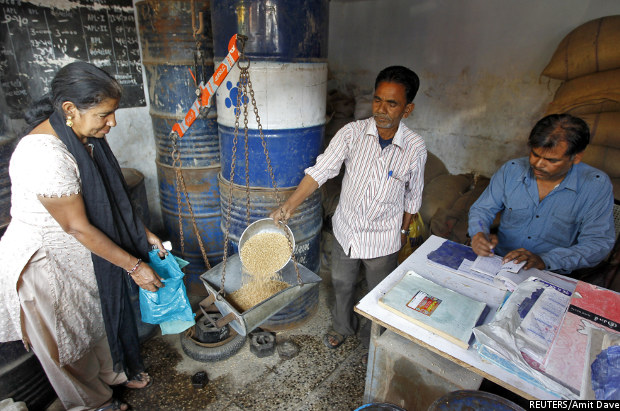4 Things India Had Going For It In 2016
A woman buys wheat from a government-run ration shop in Ahmedabad, Gujarat. The government has identified over 23 million ineligible ration cards between 2013 and 2016, and 32.1% of the fair price shops have been automated under the end-to-end computerisation of targeted public distribution system, thereby checking subsidy leaks.
From reducing subsidies by curbing malpractices to attracting 30% more foreign direct investment in the first six months, India had the following four positives going for it in 2016. Take a look:
1. Govt expects to save more on subsides
Context: Rs 5,000 crore was saved by reducing petroleum subsidies and food-subsidy leaks, IndiaSpend reported in December 2015.
Current Scenario: The government has budgeted to reduce subsides by over Rs 7,600 crore by promoting #GiveUp--a campaign encouraging people to give up liquefied petroleum gas (LPG) subsidies, cutting off LPG subsidies to people declaring income over Rs 10 lakh per annum and digitising the public distribution system.
Source: Union Budget; *Revised estimate, **Budget estimate
Source: Union Budget; *Revised estimate, **Budget estimate
Nearly 10 million LPG consumers have give up their subsidies, which has helped the government release over 14 million connections to below poverty line households as on December 24, 2016.
The government has identified over 23 million ineligible ration cards between 2013 and 2016, and 169,623 out of 527,734 fair price shops (32.1%) have been automated under the end-to-end computerisation of targeted public distribution system (TPDS), according to a reply given to the Lok Sabha (lower house of Parliament) by Food & Public Distribution Minister Ram Vilas Paswan on November 22, 2016.
The TPDS is supposed to benefit over 65 million families below the official poverty line, IndiaSpend had reported in January 2016.
2. FDI continues upward trend
Context: There was a 48% increase in foreign direct investment between October 2014 and April 2015, IndiaSpend reported in December 2015.
Current Scenario: The first six months of the current financial year (April-September 2016) saw an increase of 30% in foreign direct investment--to $21.6 billion as against $16.6 billion in April-September 2015, according to data from the department of industrial promotion & policy (DIPP).
Source: Department of Industrial Policy & Promotion
"..as a result of all these policies, foreign direct investment has reached record levels," Prime Minister Narendra Modi said in Patalganga, Maharashtra, on December 24, 2016.
3. Average balance per Jan Dhan account doubles in 2016
Context: The Pradhan Mantri Jan Dhan Yojana (Prime Minister’s People’s Wealth Programme) had created 196 million bank accounts, according to 2015 data.
Current scenario: The number of Jan Dhan accounts increased 30%, from 199 million at the beginning of 2016 to 260 million by year-end (as of December 21, 2016). Money in these accounts increased to Rs 71,000 crore by year end from Rs 29,000 crore at the end of 2015.
Average balance per Jan Dhan account doubled from Rs 1,400 at beginning of 2016 to Rs 2,800 at year end.
The proportion of zero-balance accounts declined from 32% to 24% over 2016, i.e accounts with money deposited--or non zero-balance accounts--increased from 68% to 76%.
Source: Pradhan Mantri Jan Dhan Yojana website
However, a sizeable proportion of so-called non-zero-balance accounts have Re. 1 (or similarly negligible amounts), deposited by banks to keep the accounts operational, Indian Express reported in September 2016.
About 29% of Jan Dhan accounts in Punjab National Bank, 9% in Bank of Baroda and 14% in UCO Bank were non-zero balance accounts with Re. 1 as balance, effectively making them unused accounts, the report said.
An increase of 40% in deposits in Jan Dhan accounts--from Rs 45,600 crore on November 9, 2016, to Rs 64,250 crore on November 16, 2016--was observed in the week succeeding the November 2016 decision to scrap the high denomination notes of Rs 500 and Rs 1,000.
From 42% of Jan Dhan accounts linked to Aadhaar numbers of the respective account holders at the beginning of 2016, the linkage increased to 55% by the end of 2016.
4. Swachh Bharat: 21% target complete in half-time, cess collection improves
Context: With four years to go, about 90% of the target remained unachieved for the Swachh Bharat Abhiyan (Clean India campaign), IndiaSpend reported in 2015.
Current Scenario: As many as 10.8 million household toilets were constructed in the nine-month period between April and December 2016, compared to 12.7 million constructed in the previous financial year 2015-16.
Halfway through the Clean India mission, only 21% target has been met. Two years and three months after the flagship scheme was started on October 2, 2014, 23.5 million toilets have been constructed in rural Indian households, as against the target to construct 110 million toilets by 2019.
Only three states--Kerala, Himachal Pradesh and Sikkim--have achieved 100% household toilet coverage at the end of 2016, while Uttarakhand has covered 98.4% households, according to Swachh Bharat Abhiyan data.
The programme has also helped government boost its revenue stream.
Compared to Rs 3,900 crore collected in 2015-16, Rs 6,900 crore has been collected as Swachh Bharat cess in April-December 2016, of which Rs 6,742 crore was released to states.
Swachh Bharat cess is a 0.5% component over and above the 14% service tax collected since November 15, 2015.
Odisha received the maximum funding from Swachh Bharat cess at Rs 732 crore in 2016-17.
Gujarat--ranked sixth among 32 states and union territories in the list of states in household coverage of toilets--had the second highest share of Swachh Bharat cess funds at Rs 650 crore.
As for the urban component of the Swachh Bharat mission, 2.7 million (41%) of 6.6 million toilets to be built by 2019 have been completed at the end of 2016, and 2.1 million are under construction.
We welcome feedback. Please write to respond@indiaspend.org. We reserve the right to edit responses for language and grammar.
__________________________________________________________________
“Liked this story? Indiaspend.org is a non-profit, and we depend on readers like you to drive our public-interest journalism efforts. Donate Rs 500; Rs 1,000, Rs 2,000.”



